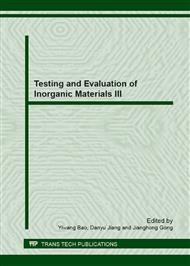[1]
J. Wang, J.B. Neaton, H. Zheng, et al, Epitaxial BiFeO3 multiferroic thin film heterostructures, Science 299 (2003) 1719-1722.
Google Scholar
[2]
A. FiIippetti, N.A. Hill, First principles study of structural, electronic and magnetic interplay in ferroelectromagnetic yttrium manganite, J. Magn. Magn. Mater. 236 (2001) 176-189.
DOI: 10.1016/s0304-8853(01)00445-0
Google Scholar
[3]
K.F. Wang, J.M. Liu, Z.F. Ren, Multiferroicity: the coupling between magnetic and polarization orders, Advances in Physics 58 (2009) 321-448.
DOI: 10.1080/00018730902920554
Google Scholar
[4]
D.Y. Wang, N.Y. Chan, R.K. Zheng et al, Multiferroism in orientational engineered (La, Mn) co-substituted BiFeO3 thin films, J. Appl. Phys. 109 (2011) 114105.
DOI: 10.1063/1.3594745
Google Scholar
[5]
T. Rojac, M. Kosec, B. Budic, et al, Strong ferroelectric domain-wall pinning in BiFeO3 ceramics, J. Appl. Phys. 108 (2010) 074107.
DOI: 10.1063/1.3490249
Google Scholar
[6]
V. Shelke, D. Mazumdar, G. Srinivasan, et al, Reduced coercive field in BiFeO3 thin films through domain engineering, Adv. Mater. 23 (2011) 669-672.
DOI: 10.1002/adma.201000807
Google Scholar
[7]
X. Ke, P.P. Zhang, S.H. Baek, et al, Magnetic structure of epitaxial multiferroic BiFeO3 films with engineered ferroelectric domains, Phys. Rev. B. 82 (2010) 134448.
Google Scholar
[8]
S. -H. Baek, C. M. Folkman, J. -W. Park, et al, The nature of polarization fatigue in BiFeO3, Adv. Mater. 23 (2011) 1621-1625.
DOI: 10.1002/adma.201003612
Google Scholar
[9]
J. Seidel, P. Maksymovych, Y. Batra, et al, Domain wall conductivity in La-Doped BiFeO3, Phys. Rev. Lett. 105 (2010) 197603.
Google Scholar
[10]
P. Maksymovych, J. Seidel, Y.H. Chu, Dynamic conductivity of ferroelectric domain walls in BiFeO3, Nano Lett. 11 (2011) 1906-(1912).
DOI: 10.1021/nl104363x
Google Scholar
[11]
S. Farokhipoor, B. Noheda, Conduction through 71° domain walls in BiFeO3 thin films, Phys. Rev. Lett. 107 (2011) 127601.
DOI: 10.1103/physrevlett.107.127601
Google Scholar
[12]
C.T. Nelson, Y. Zhang, C.M. Folkman, et al, Domain structure control of BiFeO3 films through substrate symmetry & film thickness, Microsc. Microanal. 15(Suppl 2) (2009) 1030-1031.
DOI: 10.1017/s1431927609099450
Google Scholar
[13]
Y.H. Chu, L.W. Martin, Q. Zhan, et al, Epitaxial multiferroic BiFeO3 thin films: progress and future directions, Ferroelectrics 354 (2007) 167-177.
DOI: 10.1080/00150190701454867
Google Scholar
[14]
L. You, S. Yasui, Y. Ehara, et al, Domain tuning in mixed-phase BiFeO3 thin films using vicinal substrates, Appl. Phys. Lett. 100 (2012) 202901.
DOI: 10.1063/1.4717986
Google Scholar
[15]
Y.B. Chen, M.B. Katz, X.Q. Pan, et al, Ferroelectric domain structures of epitaxial (001) BiFeO3 thin films, Appl. Phys. Lett. 90 (2007) 072907.
DOI: 10.1063/1.2472092
Google Scholar
[16]
Z.H. Chen, L. You, C.W. Huang, et al, Nanoscale domains in strained epitaxial BiFeO3 thin films on LaSrAlO4 substrate, Appl. Phys. Lett. 96 (2010) 252903.
DOI: 10.1063/1.3456729
Google Scholar
[17]
Y. Wang, Y.H. Lin, C.W. Nan, Thickness dependent size effect of BiFeO3 films grown on LaNiO3- buffered Si substrates, J. Appl. Phys. 104 (2008) 123912.
DOI: 10.1063/1.3054169
Google Scholar
[18]
F. Yan, T.J. Zhu, M.O. Lai, et al, Enhanced multiferroic properties and domain structure of La-doped BiFeO3 thin films, Scripta Mater. 63 (2010) 780-783.
DOI: 10.1016/j.scriptamat.2010.06.013
Google Scholar
[19]
F. Yan, M. -O. Lai, L. Lu, Enhanced multiferroic properties and valence effect of Ru-doped BiFeO3 thin films, J. Phys. Chem. C 114 (2010) 6994-6998.
DOI: 10.1021/jp1009127
Google Scholar
[20]
F. Yan, T.J. Zhu, M.O. Lai, et al, Role of Pb(Zr0. 52Ti0. 48)O3 substitution in multiferroic properties of polycrystalline BiFeO3 thin films, J. Appl. Phys. 110 (2011) 114116.
Google Scholar
[21]
L. You, E. Liang, R. Guo, et al, Polarization switching in quasiplanar BiFeO3 capacitors, Appl. Phys. Lett. 97 (2010) 062910.
DOI: 10.1063/1.3479911
Google Scholar
[22]
W.G. Chen, W. Ren, L. You, et al, Domain structure and in-plane switching in a highly strained Bi0. 9Sm0. 1FeO3 film, Appl. Phys. Lett. 99 (2011) 222904.
Google Scholar
[23]
F. Yan, T.J. Zhu, M.O. Lai, et al, Effect of bottom electrodes on nanoscale switching characteristics and piezoelectric response in polycrystalline BiFeO3 thin films, J. Appl. Phys. 110 (2011) 084102.
DOI: 10.1063/1.3651383
Google Scholar


